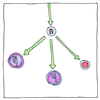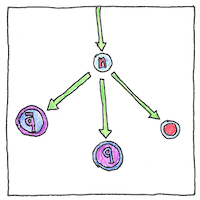Ettore Majorana
physics

|
Majorana fermion
Solutions to the Majorana equation— particles that are their own antiparticles. Fermion—an elementary particle or composite of elementary particles. Another fermion—can not occupy the same quantum state. Antiparticle—a particle with the same mass as an ordinary particle but opposite properties. Neutrino—might be a Majorana fermion, but this has not been established. Majorana fermions—found in superconductors as quasiparticle side-effects. Suspected—part of the dark matter that holds the universe together.
Pauli exclusion
I had long wondered, since atoms are mostly empty space, why they didn’t pass through each other like Aymé’s character Dutilleul who walks through walls with ease. It turns out that Wolfgang Pauli and rest of the quantum mechanics gang had an answer. Some particles do; some do not. Fermions exclude each other, but bosons can have the same quantum state. Ordinary matter is stable and has volume because electrons, protons, and neutrons are fermions that cannot be squeezed too closely together.
Quantum state
At the current time, I know everything, but if you ask then I won’t necessarily know anything. I’m probably not unhappy, nor too annoyed with the question. This I couldn’t say. You’ll never see my inner spaces, my secrets, my depths, nor will I see yours. Emotions are slippery and, even though many of us resist the concept, so is reality.



Ettore Majorana had suggested the existence of the neutron before James Chadwick proved that it existed in 1932. Ettore Majorana’s existence after his disappearance in 1938 has also been suggested.
See also in The book of science:
Readings in wikipedia: